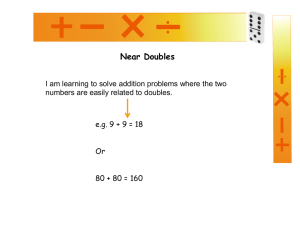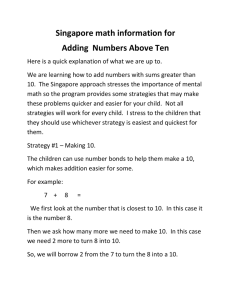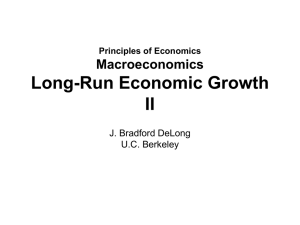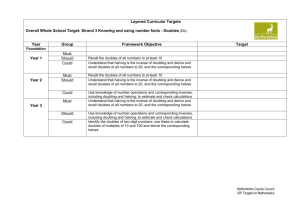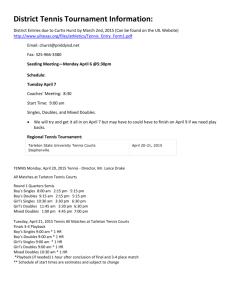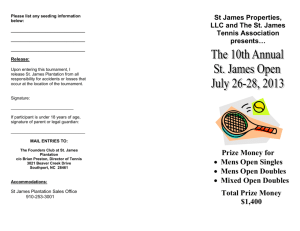Investigation 3 Note Packet
advertisement
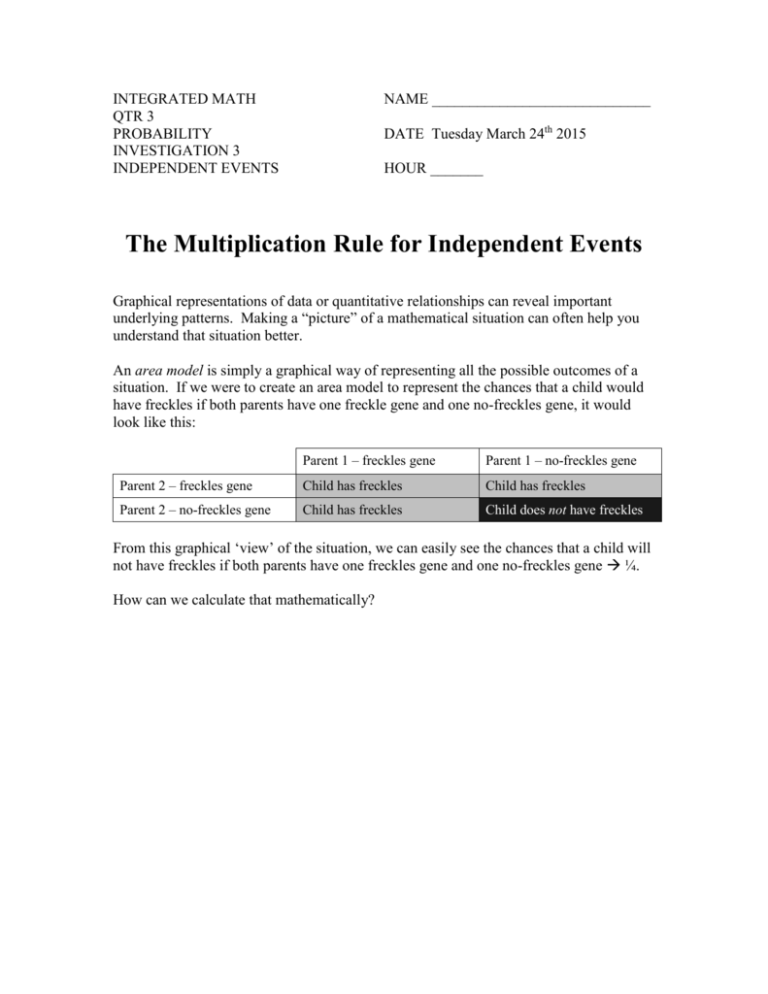
INTEGRATED MATH QTR 3 PROBABILITY INVESTIGATION 3 INDEPENDENT EVENTS NAME _____________________________ DATE Tuesday March 24th 2015 HOUR _______ The Multiplication Rule for Independent Events Graphical representations of data or quantitative relationships can reveal important underlying patterns. Making a “picture” of a mathematical situation can often help you understand that situation better. An area model is simply a graphical way of representing all the possible outcomes of a situation. If we were to create an area model to represent the chances that a child would have freckles if both parents have one freckle gene and one no-freckles gene, it would look like this: Parent 1 – freckles gene Parent 1 – no-freckles gene Parent 2 – freckles gene Child has freckles Child has freckles Parent 2 – no-freckles gene Child has freckles Child does not have freckles From this graphical ‘view’ of the situation, we can easily see the chances that a child will not have freckles if both parents have one freckles gene and one no-freckles gene ¼. How can we calculate that mathematically? Situation 1 – Shower Singing About half of all U.S. adults are female. According to a survey published in USA Today, three out of five (or 60%) adults sing in the shower. 1a. Suppose an adult from the United States is selected at random. From the information above, do you think that the probability that the person is a female and sings in the shower is equal 3 3 3 to , greater than , or less than ? 5 5 5 b. Now examine the situation using the area model shown below. Explain why there are two rows labeled “No” for “Sings in Shower” and three labeled “Yes.” Male Yes What assumption does this model make about singing habits of males and females? Yes Yes No No c. On this area model, shade in the region that represents the event: female and sings in the shower. d. What is the probability that an adult selected at random is a female and sings in the shower? Your answer should be a fraction. e. What is the probability that an adult selected at random is a male and does not sing in the shower? Your answer should be a percent. Female Situation 2 - Dice Consider this problem: What is the probability that it takes exactly two rolls of a pair of dice before getting doubles for the first time? 2a. Calculate the probability of rolling doubles (same number on each die) on a pair of 6-sided dice. You may want to reference #3 from WS 1 to help with this problem. 2b. Explain why it makes sense to label the rows of the area model as shown below. Doubles Not Doubles Not Doubles Not Doubles Not Doubles Not Doubles b. On this area model, label the six columns to represent the possible outcomes on the second roll of a pair of dice. c. On this area model, lightly shade the squares that represent the event not getting doubles on the first roll and getting doubles on the second roll. d. What is the probability of not getting doubles on the first roll and then getting doubles on the second roll? Your answer should be in unsimplified fraction form. e. Use your area model to find the probability that you will not get doubles either time. Your answer should be in unsimplified fraction form. Situation 3 - Practice Make an area model to help you determine the probabilities of each situation below. Be sure to include correct labels and shading. 3a. Use area models to answer the question: About 80% of Americans pour shampoo into their hand rather than directly onto their hair. What is the probability that both your teacher and the President of the U.S. pour shampoo into their hand before putting it on their hair? You need to consider how many rows and columns are necessary here. Write your answer as a percent. 3b. Use area models to answer the question: About 25% of Americans put catsup directly on their fries, rather than on the plate. What is the probability that both your school principal and your favorite celebrity put catsup directly on their fries? Write your answer as a decimal. Situation 4 – Multiplication Rule 4a. For the previous situations, the pairs of events in each of those problems are independent events: knowing whether one of the events occurs does not change the probability that the other event occurs. b. Suppose A and B are independent events. The probability symbolically is: P(A and B) The notation P(A and B) is read: “the probability of event A and event B occurring." When A and B are independent events, then P(A and B) = P(A) ∙ P(B) State this Multiplication Rule in words. (A.K.A. Write the rule as a written sentence) Often a probability problem is easier to understand if it is written in words that are more specific than the words the original problem uses. For example, consider the problem: What is the probability of taking exactly two tries to roll doubles? You could express and calculate this probability in the following manner: P(don’t roll doubles first try and do roll doubles second try) = P(don’t roll doubles first try ) P(do roll doubles second try ) = P(no dbls ) P(do get dbls) 5 1 = 6 6 5 = 36 5. For each event below, show how you could mathematically compute the probability without making an area model (we are making an assumption of independence here). Show your work (as usual). Be careful counting outcomes!!!!! a. Find P(male and doesn’t sing in the shower). Your final answer should be an unsimplified fraction and then a decimal. b. Find P(female and sings in the shower). Your final answer should be a simplified fraction. c. Find P(not doubles on the first roll and not doubles on the second roll). Your final answer should be an unsimplified fraction and then a percent. 6a. Suppose Shiomo is playing a game in which he needs to roll a pair of dice and get doubles and then immediately roll the dice again and get a sum of six. He wants to know the probability that this will happen. (this is written as P(doubles,sum of six)) Which of the following best describes the probability Shiomo wants to find? Option 1: P(gets doubles first roll or gets sum of six second roll) Option 2: P(gets doubles first roll and gets sum of six second roll) Option 3: P(gets doubles and sum of six) b. How many total outcomes are there when rolling two dice? Hint: Reference WS 1. c. Explain why the Multiplication Rule is appropriate to use here. d. What is the probability? Your answer should be a simplified fraction. Note: When counting rolls that have a sum of six, 5-1 is considered different than 1-5) e. Find P(doubles, sum of six, sum of eleven). Answer as a simplified fraction. 7a. Suppose A, B, and C are three independent events. Write a rule for calculating P(A and B and C). You may want to use your method in 6e. b. According to the National Center for Education Statistics, the percentage of students who are homeschooled in the U.S. is 2%. If you pick 10 students at random in the U.S., find P(none homeschooled). Show the multiplication and give your answer as a decimal rounded to the nearest thousandth. c. You are randomly picking two cards from a standard deck (52 total cards) one at a time, replacing it each time and thoroughly reshuffling each time. Find P(heart, ten). Your answer should be simplified fraction. d. In the United States, about 105 boys are born for every 100 girls. What is the probability (to the nearest hundredth of a percent) that a family with two children will have an older girl and a younger boy? Is this probability different than the probability that the family will have an older boy and a younger girl? Explain your reasoning. e. In the game Monopoly, Jenny is sent to jail. She wants to know the probability that she will fail to roll doubles in three tries. Calculate such a probability to the nearest percent. Male Yes Yes Yes No No Doubles Not Doubles Not Doubles Not Doubles Not Doubles Not Doubles Female
